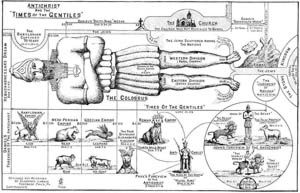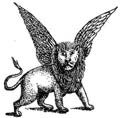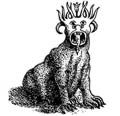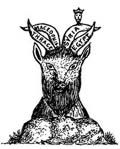
| Home |
What We Believe |
Our Purpose |
Contact Us |
Pages By Topic |
Pages By Title |
EARNESTLY CONTENDING FOR THE FAITH:
CLARENCE LARKIN:
THE BOOK OF REVELATION:
ISAIAH'S AND DANIEL'S FOREVIEW
(A PDF Copy Of The Complete Book Is Available Here)
(A WordPerfect Copy Of The Complete Book Is Available Here)
CAUTION: The PDF Of This File Is Huge (89 MB); The WordPerfect File is Huge (54 MB)

|
THE LORD JESUS CHRIST IS GOD MANIFEST IN THE FLESH. THAT IS WHY HE IS GOD. |
|
Do you know for a fact that if you were
to die today that you would not go to hell? If you do not know, click here. |
BOOK OF REVELATION
A Study of
The Last Prophetic Book
of Holy Scripture
by Clarence Larkin
1919
|
The Prophet Isaiah sees the Antichrist as the "ASSYRIAN." Isa. 10:5, 12, 24; 30:27-33. In Isa. 11:4, a chapter which is evidently Messianic, we read that among other things which the Messiah will do--"He shall smite the earth with the 'rod of His mouth,' and with the 'breath of His lips' shall He slay 'THE WICKED'." The word translated "THE WICKED," is in the singular number, and cannot refer to wicked persons in general, but to some one person who is conspicuously wicked. The expression is strikingly like that of Paul's in 2. Thess. 2:8. "Then shall that 'WICKED' be revealed, whom the Lord shall consume with the 'Spirit of His Mouth,' and shall destroy with the 'Brightness of His Coming'." It is evident that Isaiah and Paul refer to the same individual, who can be no other than the Antichrist. In Isa. 14:4-17 there is a description of a "King of Babylon" who shall smite the people in his wrath, and rule the nations in anger. He is called "LUCIFER, Son of the Morning," and his fall is described. He is cast down to Hell (Sheol, the Underworld), where his coming creates a great stir among the kings of the earth that have preceded him, and who exclaim when they see him--"Art thou .also become weak as we? Art thou become like unto us? . . . Is this the man that made the earth to tremble, that did shake kingdoms; that made the world as a wilderness and destroyed the cities thereof; that opened not the house of his prisoners?" There has never as yet been such a King of Babylon as is here described. It must therefore refer to some future King of Babylon, when Babylon shall be rebuilt, as we shall see it is to be. Verses 12 to 14 evidently refer to Satan, and are descriptive of him before his fall, but as he is to incarnate himself in the Antichrist, who is to be a future King of Babylon, it explains the source of the pride and presumption of Antichrist, which will lead to his downfall, as it did to Satan's. 1. The Colossus. We now turn to Daniel. The Book of Daniel may be divided into two parts. The first six chapters are Historical, the last six are Prophetical. The Book contains one "Dream" by Nebuchadnezzar, and four "Visions" by Daniel, all relating to the "Times of the Gentiles." Nebuchadnezzar in his "Dream" saw a "Great Image" or "COLOSSUS." The Head of the "Image" was of fine gold, its Breast and Arms of silver, its Belly (Abdomen) and Thighs (Hips) of brass, its Legs of iron, and its Feet of iron and clay. This Image was destroyed by a "Stone" cut out of a mountain supernaturally. The "Stone" in turn became a great mountain and filled the WHOLE EARTH. Dan. 2:31-35. The four metals of which the "COLOSSUS" was composed represented Four Worldwide Empires which were to arise in succession. Dan. 2:37-40. Four great Empires, and only four, were to succeed each other in the government of the world, from Nebuchadnezzar (B. C. 606) to the "Second Coming" of Christ--the Babylonian, Medo-Persian, Grecian, and Roman. These Empires are not only made known as to number, but their names, in the order of their succession, are given. The First–BABYLONIAN" is indicated by Daniel while interpreting the vision to Nebuchadnezzar. "THOU art this Head of Gold." Dan. 2:38. The Second--the "MEDO-PERSIAN," Daniel points out in his account of "Belshazzar's Feast," by the emphatic words--"In that night was Belshazzar the King of the Chaldeans slain, and Darius the MEDIAN took the Kingdom." Dan. 5:30-31. The Third--the "GRECIAN," is mentioned in Dan. 8:20-21, "the Ram which thou sawest having 'two horns' are the kings of Media and Persia, and the 'Rough Goat' is the King of Grecia (Greece)." The Fourth--the "ROMAN," is referred to in Dan. 9:26 as--"the PEOPLE of the 'Prince' that should destroy the city (Jerusalem) and the Sanctuary," and we know that it was the ROMANS under Titus, that destroyed Jerusalem in A. D. 70. While these Four Great Empires were to follow each other in the order named, they were not to follow without a break. The Babylonian lasted from B. C. 606 to B. C. 538. The Medo-Persian from B. C. 538 to B. C. 330. The Grecian from B. C. 330 to B. C. 323. Then the Grecian was broken up into four parts, Thrace, Macedonia, Syria, and Egypt, and the last of these was conquered by the Romans in B. C. 30, and the Roman Empire lasted from B. C. 30 to A. D. 364, when it was divided into its Eastern and Western Divisions. Since then there has been no leading world Empire, and cannot be according to this prophecy until Christ sets up His "STONE" or "Millennial Kingdom," as represented by the "Stone" that smites the "COLOSSUS" on its feet, for this "STONE KINGDOM" is to fill the whole earth, and thus be universal. This "STONE" cannot be Christianity, for it does not fill the earth by degrees, and thus crowd out the "COLOSSUS," but it at One Blow DEMOLISHES IT. The action of the "STONE" is that of JUDGMENT not Grace, and is SUDDEN and CALAMITOUS. Again the TIME of the destruction is not until after the formation of the Toes, and we know that the "TWO LIMBS" did not appear until A. D. 364, and the "TEN TOES" have not yet developed. The TIME when the "STONE" falls on the "FEET" we are told is "in the days of THOSE KINGS" (Dan. 2:44), that is the Kings represented by the "Ten Toes," which as we shall see corresponds with the "Ten Horns" of Daniel's "Fourth Wild Beast," Dan. 7:7-8, and with the "Ten Kings" of John's "Beast." Rev. 17:12. The first Four Kingdoms were literal Kingdoms, and so must the "Stone Kingdom" be, for it is to take the place of those Kingdoms and fill the whole earth. It represents therefore the "Millennial Kingdom" of Christ, for He is the "STONE" of the Scriptures. Matt. 21:44. From what has been said we see that the "COLOSSUS" of "Nebuchadnezzar's Dream" symbolized the "World Kingdoms" in their Unity and Historical Succession. Gentile dominion is represented by a huge "METALLIC MAN." The degeneration of the "World Kingdoms" is seen in the diminishing value of the metals used. Silver is worth less than gold, brass than silver, iron than brass, and clay than iron. The weight of the "COLOSSUS" also declines; the specific gravity of gold is 19.5, of silver 10.47, of brass 8, of cast-iron 5, and of clay 1.93. The "Colossus" is TOP HEAVY. The character of the governing power also deteriorates from an "Absolute Monarchy" under Nebuchadnezzar, to an "Autocratic Democracy" symbolized by the mixture of the iron and clay of the Feet. In other words the governing power passes from the Head, the organ that ought to direct the members of the body, to the Feet, which are only made to carry the body whither the Head directs. We have dwelt thus at length on the "Colossus," for it is only as we understand it, that we can understand the meaning of the "Wild Beasts" that Daniel saw come up out of the sea. 2. The Vision of the "FOUR BEASTS." Forty-eight years after Nebuchadnezzar had his "Dream," B. C. 555, Daniel in vision stood upon the shore of the "Great Sea" (the Mediterranean), and saw four "Great Beasts" come up out of the sea in succession.
FIRST BEAST. The "First Beast" was like a LION and had Eagle's Wings, and as the Prophet watched it, he saw it lifted up from the earth, and made to stand upon its feet as a Man, and a Man's Heart was given to it. Dan. 7:4. We have only to visit the British Museum, London, and examine the Colossal Stone Lions with the "wings of an eagle" and the "head of a man," disinterred from the ruins of Babylon and Assyria by Sir Henry Layard between the years 1840 and 1850 A. D., to see that this "FIRST BEAST" stands for Babylon and its King--Nebuchadnezzar. The peculiarity of this "FIRST BEAST" was that it had "Eagle's Wings." This combination of the LION, the "King of Beasts," and the EAGLE, the "King of Birds," corresponded to the Royalty of the "Head of Gold" of the "COLOSSUS," and typified the "Eagle-like" swiftness of the armies of Nebuchadnezzar. The "Plucking of the Wings" doubtless referred to the "Beastly Insanity" of Nebuchadnezzar (Dan. 4:20-27), and the "lifting up," and causing to stand upon its feet "as a MAN," to his restoration to sanity.
SECOND BEAST. The "Second Beast" was "like to a BEAR, and it raised up itself on one side, and it had "Three Ribs" in the mouth of it, between the teeth of it: and they said thus unto it Arise, devour much flesh." Dan. 7:5. The bear is the strongest beast after the lion and is distinguished for its voracity, but it has none of the. agility and majesty of the lion, is awkward in its movements, and effects its purpose with comparative slowness, and by brute force and sheer strength. These were the characteristics of the Medo-Persian Empire. It was ponderous in its movements. It did not gain its victories by bravery or skill, but overwhelmed its enemies by hurling vast masses of troops upon them. Xerxes' expedition against Greece was undertaken with 2,500,000 fighting men, who with the camp followers made up an army of 5,000,000. Other Persian generals had armies running up into the 100,000's of men. It is easy to be seen that the movements of such enormous bodies of men would "devour much flesh," not only in the destruction of their enemies, but thousands would die of disease and exposure and the countries through which they passed would become famine-stricken by the loss of food seized to feed such armies. The side of the "BEAR" which raised up to attack signifies Persia, in which lay the greatest military strength, and corresponded to the "right shoulder and arm" of the "Colossus." The "Three Ribs" stood for the three Kingdoms of Lydia, Babylon and Egypt, which formed a "Triple Alliance" to check the Medo-Persian power, but were all destroyed by it.
THIRD BEAST. The "Third Beast" was "like a LEOPARD, which had upon the back of it four wings of a fowl; the 'BEAST' had also four heads; and dominion was given to it." Dan. 7:6. The Leopard is the most agile and graceful of creatures; but its speed is here still further assisted by "wings." Slight in its frame, but strong, swift and fierce, its characteristics render it a fitting symbol of the rapid conquests of the Greeks under Alexander the Great, who, followed by small but well-equipped and splendidly brave armies, moved with great celerity and in about 10 years overthrew the unwieldy forces of Persia, and subdued the whole civilized world. The "four wings of a Fowl" indicate, that, as a "fowl" does not fly high, the armies of Alexander were fitted mainly for lowland fighting. There is an incongruity between the number of "wings" and the number of "heads" of the Leopard. "Four heads" call for "four pair of wings." Why only "four" wings we do not know, unless they denote the four quarters of the earth into which Alexander sought to extend his Kingdom. The "Four Heads" of the LEOPARD represent the "Four Kingdoms" into which the Empire of Alexander was divided by his generals, namely Thrace, Macedonia, Syria and Egypt. The "Third Beast" corresponds to the "Abdomen" and "Hips" of the "COLOSSUS."
FOURTH BEAST. The "Fourth Beast" was unlike any Beast that Daniel had ever seen or heard about. It was "dreadful and terrible, and strong exceedingly, and it had great IRON TEETH. It devoured and brake in pieces, and stamped the residue (the other Beasts) with the feet of it; and it was diverse from all the 'BEASTS' that were before it, and it had 'TEN HORNS'." Dan. 7:7. The fact that the "Fourth Beast" had "Iron Teeth," and that there were "Ten Horns" on its Head, the "iron" corresponding to the "Iron Limbs," and the "Ten Horns" to the "Ten Toes" of the "COLOSSUS," would cause Daniel to see that the "Fourth Beast" stood for the Fourth World Empire, the ROMAN. But as Daniel "considered" the "Ten Horns," he was amazed to see another "Horn," a LITTLE one, come up among them, and before whom there were "three" of the "First Horns" plucked up by the roots, that is destroyed. And as he examined the "LITTLE HORN" more closely he noticed that it had Eyes like the eyes of a Man, and the Mouth of a Man speaking great things. Dan. 7:8. This mystified and troubled Daniel. He had seen nothing corresponding to it on the "Ten Toes" of the "COLOSSUS." It must mean some new and additional revelation that God had not seen fit to impart to the Gentile King Nebuchadnezzar, and that was reserved for Daniel and his people (the Jews), for we must not forget that Daniel's own visions, in the last six chapters' of the Book, have to do with God's dealings with the Jewish People in the "LATTER DAYS." Dan. 10:14. So Daniel approached one of the "Heavenly Messengers" that stood by and asked him the meaning of what he had seen. He was told that the "Four Beasts" stood for "FOUR KINGS" or "KINGDOMS" (vs. 23), that should arise out of the earth. Then Daniel wanted to know the "truth" about the "FOURTH Beast," which was so diverse from the other three, and particularly about the "LITTLE HORN" that came up among the "Ten Horns" on its head. In explanation Daniel was told that the "Ten Horns" on the "Fourth Beast" represented "TEN KINGS" that shall arise, and that the "Little Horn" was a "King" that should rise among them and subdue three of them, and that he would be a "PERSON" of remarkable intelligence and great oratorical powers, having a mouth speaking great things. That he would be audacious, arrogant, imperious, and persecuting, and change "times and laws," and that the "Saints of the Most High" (Daniel's People) would be given into his hands for a "Time, and Times, and the Dividing of Time," or 3� years. In this Vision of the "Four Beasts" we see "Degeneration" just as we saw it in the metals of the "COLOSSUS." The descent is from the LION, the "King of Beasts," to a nondescript "MONSTER" that defies description. The reason why these "Four Kingdoms" are rep-resented first as a "Golden Headed Metallic Image," and then as a succession of "Wild Beasts," is to show the difference between Man's view and GOD'S view of the World Kingdoms. Man sees in them the concentration of wealth, majesty and power; GOD sees them as a succession of rapacious Wild Beasts devouring one another. 3. The Vision Of The "RAM" And The "HE-GOAT."
The explanation as to the meaning of the "LITTLE HORN" perplexed Daniel, and he voiced it by saying "My 'cogitations' much troubled me, and my countenance changed in me (he had a sad look); but I kept the matter in my heart." Dan. 7:28. To comfort His Servant, God, two years later, transported Daniel in vision to Shushan, the Capital of Persia, and as he stood on the bank of the river Ulai, he saw a RAM which had "Two Horns," one higher than the other, and the higher came up last. He saw the RAM push "Westward," and "Northward," and "Southward," and nothing could stand before it, and it did according to its will. Dan. 8:4. While Daniel was "considering" what the Vision of the RAM meant, he saw a HE-GOAT come from the West unmolested, and he noticed it had a "NOTABLE HORN" between its eyes, and when it reached the RAM it was moved with "choler" or anger against it, and smote it with "fury," and broke its. "Two Horns," and knocked it down and stamped upon it. Then the HE-GOAT waxed great, but when it became strong its "GREAT HORN" was broken off, and "Four Notable Horns" came up in its place, and out of one of them sprang a "LITTLE HORN" which waxed exceedingly great toward the "South," and toward the "East," and toward the "Pleasant Land" (Palestine), Dan. 8; 5-9.
When Daniel sought for the meaning of this Vision he heard a voice say--"Gabriel, make this man to understand the Vision." Then Gabriel said to Daniel the Vision belongs to the "Time of the End" (the End of the Times of the Gentiles), and is to make thee know what shall come to pass in the "Last End of the Indignation" (the Great Tribulation). Dan. 8:15-19. Gabriel then informed Daniel that the "RAM" stood for the "Medo-Persian Empire," with its two Kings, Darius and his nephew Cyrus, that the "HE-GOAT" stood for the "Grecian Empire," the "GREAT HORN" between its eyes for its first King (Alexander the Great), and that the "FOUR HORNS" that took the place of the "GREAT HORN," stood for "Four Kingdoms" into which the "Grecian Empire" should be divided. This explanation cleared up things considerably for Daniel. It revealed to him that the "TWO HORNS" of the RAM, one higher than the other, and the "TWO SHOULDERS" of the BEAR, one higher than the other, and the "TWO ARMS" of the COLOSSUS, stood for the same thing, the double Empire of Medo-Persia. He also saw that the "FOUR HORNS" that came up in the place of the "GREAT HORN" corresponded to the "FOUR HEADS" of the LEOPARD, and therefore must correspond with the "ABDOMEN" and "HIPS" of the COLOSSUS, and stand for the Grecian Empire, and its "Fourfold Division" among the Generals of Alexander the Great. But Daniel was still troubled as to the meaning of the "LITTLE HORN" that he saw come out of one of the "Four Horns" of the HE-GOAT, and Gabriel told him that it stood for a King of "Fierce Countenance" who should stand up in the "LATTER TIME" of the Kingdom, and who should stand up against the "PRINCE OF PRINCES" (Christ). Dan. 8:23-25. The description of this "LITTLE HORN" so clearly corresponded to the description of the "LITTLE HORN" that Daniel saw arise amid the "Ten Horns" of the "Fourth Wild Beast," that he saw they described and stood for the same Person. The revelation so overcame Daniel that he "fainted," and was sick certain days. Dan. 8:27 4. The Vision Of The "KINGS OF THE NORTH AND SOUTH." While Daniel had revealed to him that the "LITTLE HORN" should come out of one of the "Four Kingdoms" into which the Empire of Alexander the Great was divided, he was not at that time told which one, but 20 years later, in B. C. 533, the information was imparted to him in a Fourth Vision. He saw in vision two Kings warring against each other. One was called the "King of the North," the other the "King of the South." This chapter (Dan. 11:1-45) is one of the most wonderfully minute as to prophetic details of any chapter in the Bible. It corresponds exactly with the profane history of the kings of Egypt and Syria for over 350 years. From verse 5 to verse 31 we have an account of what is called the "wars" of the "Kings of the North" (Syria) and of the "Kings of the South" (Egypt). These end with the close of the reign of Antiochus Epiphanes, B. C. 164. Verses 32-35 cover the whole period from B. C. 164 down to the "Time of the End," that is, until the "Seventieth Week" of Daniel's "Seventy Weeks." At verse 36 the "WILFUL KING" appears, and from that verse down until the end of the Book of Daniel we have an account of what is to befall Daniel's People in the "Latter Days." As the description of the "WILFUL KING" corresponded with the description of the "LITTLE HORN" of the "Fourth Wild Beast" and the "LITTLE HORN" of the "He-Goat," and they were all to appear at the same time--the "Time of the End." Daniel understood that they referred to one and the same Person, and as the "WILFUL KING" would be the "King of the NORTH," that is, of Syria, Daniel saw that the "LITTLE HORN" was to rise on the "SYRIAN HORN" of the "He-Goat," in other words that the "LITTLE HORN," or "Antichrist," shall come out of SYRIA, and as Syria included Assyria that the "LITTLE HORN" of Daniel is the same as the "Assyrian" of Isaiah. "When the Lord hath performed His whole work upon Mount Zion and on Jerusalem (which will not be until Christ comes back), I will punish the fruit of the stout heart of the KING OF ASSYRIA (Antichrist) and the glory of his high looks." Isa. 10:12. I will break the ASSYRIAN (Antichrist) in My Land (Palestine), and upon My mountains tread him under foot; then shall his yoke depart from off them (Israel), and his burden from off their shoulders." Isa. 14:25. The context shows that this prophecy is connected with the restoration of Israel to their own land, not after the Babylonian Captivity, but a restoration that is still future, for the Assyrian Empire had been swallowed up by the Babylonian when the Prophet wrote and the ASSYRIAN King here mentioned must be some future Assyrian King, for he is to be brought to Palestine and destroyed there. We must not allow ourselves to be confused by the different names given the Antichrist, as the "King of Tyrus," the "King of Babylon," and the "King of Assyria," for that section of the world will comprise one territory in the days of the Antichrist and he will be known by all of these titles. From what we have thus far learned of the Antichrist, the probability is that he will be a SYRIAN JEW, for it is not likely that the Jews will accept as their Messiah one who is not a Jew, unless the claimant by false pretense makes them believe he is one. This, however, does not prevent the Antichrist being a Roman citizen, and the political head of the revived Roman Empire, for Saul of Tarsus was both a Jew and a Roman citizen. Those who claim that the "LITTLE HORN" of Dan. 7, and the "LITTLE HORN" of Dan. 8, are not the same, because the "LITTLE HORN" of Dan. 7 arises amid the "Ten Horns" of the "Fourth Wild Beast," which represents the Roman Empire, and the "LITTLE HORN" of Dan. 8, arises on one of the Horns of the "He-Goat" which represents the Grecian Empire, and corresponds to the "Third Wild Beast," forget that the Vision that the Apostle John had of the revived Roman Empire (Rev. 13:1-2), the Roman Empire in its last stage, reveals the fact that the "last stage" of the Roman Empire will include all the characteristics of the whole Four Empires, Babylonian, Medo-Persian, Grecian and old Roman. This is seen in the character of the "BEAST" John saw come up out of the sea. It was like unto a LEOPARD (Greece), with the feet of a BEAR (Medo-Persia), and the mouth of a LION (Babylon).
The fact that the BODY of the "BEAST" was like a LEOPARD (Greece), reveals the fact that the preponderating feature of the revived Roman Empire will be GRECIAN, and that therefore the "Ten Federated Kingdoms," represented by the "Ten Horns" of the "Beast," will include the FOUR KINGDOMS into which the GRECIAN Empire was divided, viz., Egypt, Macedon, Thrace and SYRIA. It follows therefore that the "LITTLE HORN" of the "He-Goat" (Greece), will be the LITTLE HORN that rises among the "Ten Horns" of the "Fourth Wild Beast" (Rome), for Syria, one of the four divisions of the Grecian Empire, will be one of the component parts of the Revived Roman Empire. Again those who claim that Antiochus Epiphanes (B. C. 175-165), a king of Syria, was the LITTLE HORN" of the "He-Goat," overlook the fact, that, while Antiochus Epiphanes devastated Palestine and caused an "idol altar" to be erected on the Brazen Altar of the Temple, on which he offered swine-flesh, which was an abomination to the Jews, he does not fulfil the description of the "LITTLE HORN" of the "He-Goat" (Dan. 8:9-12, 23-25), for Antiochus Epiphanes, nor any other ruler of the past, ever stood up against JESUS, the "Prince of Princes." Neither was Antiochus Epiphanes "broken without hand." He died a natural death at Tabae in B. C. 165. But the "LITTLE HORN" of the "He-Goat" is to be "broken without hand." His Kingdom is to be destroyed by a "stone cut out of the mountain WITHOUT HANDS," and he himself shall be "paralyzed" by the "brightness of the Lord's Coming" (1. Thess. 2:8), and he shall be cast ALIVE into the "Lake of Fire." Rev. 19:20. There is no intimation in Scripture that Antiochus Epiphanes is even to be regarded as a "type" of Antichrist. They are distinct historical personages, and though they resemble each other in some respects, yet they must not be confounded with each other. After this prolonged exposition of Daniel's "Foreview" of the Antichrist, which has seemed necessary to a proper understanding of the meaning of the "Beast" which John saw come up out of the sea, we now turn to–
|
 |
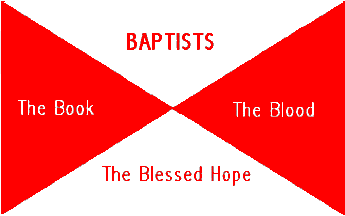 |
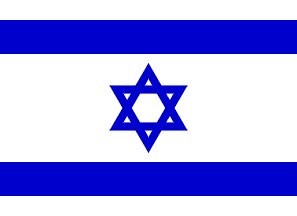 |
| Back To Previous Topic | Back To Contents Page | Forward To Next Topic |
| Back To Top | Back To Bible Prophecy Main Page | Back To Home Page |

